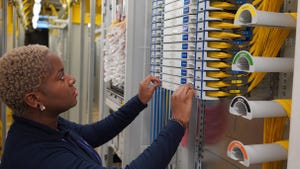Infineon Preps for VDSL2
Already among the ADSL leaders, Infineon will give VDSL another shot at Supercomm
May 18, 2005

Hoping to build on its profitable broadband chips franchise, Infineon Technologies AG (NYSE/Frankfurt: IFX) is planning to beef up its VDSL offerings.
The company claims a high-ranking spot in the ADSL universe, and it's tried VDSL chips before. But Infineon's technology of choice got battered in a standards war about two years ago, apparently causing the company to retreat (see Infineon Supports VDSL and QAM vs DMT Battle Lingers On).
Infineon still offers those chips but is ready to move on to VDSL2, a new standard that could be ratified by next week, says Imran Hajimusa, Infineon's director of marketing for access ICs. "We will be making announcements around Supercomm about VDSL2," Hajimusa says.
VDSL has been put into a niche role because, while the technology provides speedier connections than ADSL, it doesn't have the same reach. VDSL's primary markets have been in Asia and parts of Europe as a result. But fiber-to-the-node (FTTN) plans from carriers such as SBC Communications Inc. (NYSE: SBC) could change that, as they rely on a high-speed DSL connection to reach some homes (see BellSouth: Access Will Rise Again and SBC Sheds Light on 'Lightspeed').
In fact, a Light Reading Insider report last fall noted Bell Canada and Qwest Communications International Inc. (NYSE: Q) were both using VDSL, with Qwest having liked 40,000 customers with a combination of fiber and VDSL (see Carriers Prep DSL Wave Part II ).
"We see a great potential for VDSL2 in North America as well as in Korea," Hajimusa says.
ADSL2+ could be used for some FTTN plans, but VDSL might find an edge. "Our belief is that for triple play offerings -- for streaming audio and video -- that VDSL is the best technology," says Melissa Yocum, analyst with IMS. "My understanding is that ADSL2+ still has some compression concerns when it comes to video."Infineon's competition would include VDSL specialists Ikanos Communications Inc. and Metalink Ltd. (Nasdaq: MTLK), which have been selling into Asian markets with the promise of speeds up to 100 Mbit/s, and newcomer ElectriPHY Corp., which uses a technology called dynamic spectral management (DSM) to extend VDSL's reach (see VDSL Races to 100 Mbit/s and ElectriPHY Intros VDSL Chipset).
Some familiar faces could be in the mix, too. Texas Instruments Inc. (NYSE: TXN) included VDSL in its Uni-DSL (UDSL) technology launched a year ago, and Broadcom Corp. (Nasdaq: BRCM) has long been expected to produce VDSL chips (see TI Proposes FTTH Alternative).
Being profitable, broadband access gets a star role in CEO Wolfgang Ziebart's efforts to bring Infineon back to health, says Christian Scherp, VP of communications for Infineon Technologies North America. "All businesses need to be profitable in 2005," Scherp says.
Ziebart is nearly done with a restructuring that brought some changes to the communications unit, where Infineon combined wireless and wireline into one division. More notably, the company divested nearly all of its optical-networking components and chips, selling pieces to Finisar Corp. (Nasdaq: FNSR) and Exar Corp. (Nasdaq: EXAR) earlier this year (see Ericsson Signs Maxis Deal, Exar Buys Infineon ON Unit, and Finisar Buys a Bit of Infineon).
What's left in the communications department includes chips for cellphones, voice processing (including VOIP), and DSL. The division also offers home networking devices garnered in last year's acquisition of ADMtek (see Infineon Aqcuires ADMtek ).
The one optical family Infineon didn't sell was its Ethernet-over-Sonet chips. And contrary to previous reports, Infineon is saying it plans to continue product development for those devices. "We have an excellent design-in base for those [chips], especially at OC48," Scherp says.
— Craig Matsumoto, Senior Editor, Light Reading
Read more about:
OmdiaYou May Also Like










